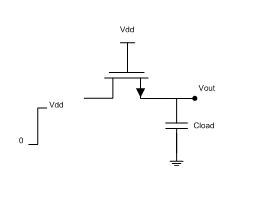naalald
Full Member level 4
What do you suggest for estimating the on resistance of a switch? I think of giving a Vdd to its gate (for a simple NMOS or a transmission gate) and applying a pulse to its input. I put a capacitor Cload in the output; like this

The output will follow the input exponentially with a time constant RC; C is the capacitor Cload and R will be the on resistance of the switch. By calculating the time constant, we can estimate the on resistance of the switch. How is the this test?
Any other suggestion?
Thanks.

The output will follow the input exponentially with a time constant RC; C is the capacitor Cload and R will be the on resistance of the switch. By calculating the time constant, we can estimate the on resistance of the switch. How is the this test?
Any other suggestion?
Thanks.